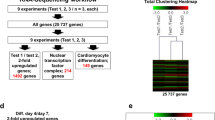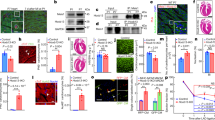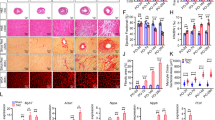Abstract
FKBP12, a cis–trans prolyl isomerase that binds the immunosuppressants FK506 and rapamycin, is ubiquitouslyexpressed and interacts with proteins in several intracellular signal transduction systems1.Although FKBP12 interacts with the cytoplasmic domains of type I receptors of the transforming growth factor-β(TGF-β) superfamily in vitro, the function of FKBP12 in TGF-β superfamily signalling iscontroversial2,3,4,5,6. FKBP12 also physicallyinteracts stoichiometrically with multiple intracellular calcium release channels including the tetrameric skeletal muscle ryanodine receptor(RyR1)7,8. In contrast, the cardiacryanodine receptor, RyR2, appears to bind selectively theFKBP12 homologue, FKBP12.6 (9, 10). To define the functions of FKBP12 in vivo, we generated mutantmice deficient in FKBP12 using embryonic stem (ES) cell technology. FKBP12-deficient mice have normal skeletal muscle buthave severe dilated cardiomyopathy and ventricular septal defects that mimic a human congenital heart disorder, noncompaction of leftventricular myocardium11,12. About 9% of themutants exhibit exencephaly secondary to a defect in neural tube closure. Physiological studies demonstrate that FKBP12 is dispensable forTGF-β-mediated signalling, but modulates the calcium release activity of both skeletal and cardiac ryanodinereceptors.
This is a preview of subscription content, access via your institution
Access options
Subscribe to this journal
Receive 51 print issues and online access
$199.00 per year
only $3.90 per issue
Buy this article
- Purchase on Springer Link
- Instant access to full article PDF
Prices may be subject to local taxes which are calculated during checkout






Similar content being viewed by others
References
Snyder, S. H. & Sabatini, D. M. Immunophilins and the nervous system. Nature Med. 1, 32–37 (1995).
Wang, T.et al. The immunophilin FKBP12 functions as a common inhibitor of the TGFβ family type I receptors. Cell 86, 435–444 (1996).
Chen, Y.-G., Liu, F. & Massagué, J. Mechanisms of TGFβ receptor inhibition by FKBP12. EMBO 13, 3866–3876 (1997).
Charng, M.-J., Kinnunen, P., Hawker, J., Brand, T. & Schneider, M. D. FKBP12 recognition is dispensable for signal generation by type I transforming growth factor-β receptors. J. Biol. Chem. 271, 22941–22944 (1996).
Okadome, T.et al. Characterization of the interaction of FKBP12 with the transforming growth factor-β type 1 receptor in vivo. J. Biol. Chem. 271, 21687–21690 (1996).
Zimmerman, C. M. & Mathews, L. S. Activin receptors: cellular signalling by receptor serine kinases. Biochem. Soc. Symp. 62, 25–38 (1996).
Jayaraman, T.et al. FK506-binding protein associated with the calcium release channel (ryanodine receptor). J. Biol. Chem. 267, 9474–9477 (1992).
Brillantes, A. B.et al. Stabilization of calcium release channel (ryanodine receptor) function by FK506-binding protein. Cell 77, 513–523 (1994).
Timerman, A. P.et al. Selective binding of FKBP12.6 by the cardiac ryanodine receptor. J. Biol. Chem. 271, 20385–20391 (1996).
Lam, E.et al. Anovel FK506 binding protein can mediate the immunosuppressive effects of FK506 and is associated with the cardiac ryanodine receptor. J. Biol. Chem. 270, 26511–26522 (1995).
Chin, T. K., Perlof, J. K., Williams, R. G., Jue, K. & Mohrmann, T. Isolated noncompaction of left ventricular myocardium, a study of eight cases. Circulation 82, 507–513 (1990).
Ritter, M.et al. Isolated noncompaction of the myocardium in adults. Mayo Clin. Proc. 72, 26–31 (1997).
Van Duyne, G. D., Standaert, R. F., Karplus, P. A. & Schrieber, S. L. Atomic structure of FKBP-FK506, an immunophilin-immunosuppressant complex. Science 252, 839–842 (1991).
Rossant, J. Mouse mutants and cardiac development, new molecular insights into cardiogenesis. Circ. Res. 78, 349–353 (1996).
Olson, E. N. & Srivastava, D. Molecular pathways controlling heart development. Science 272, 671–676 (1996).
Chen, Z.-F. & Behringer, R. R. Twist is required in head mesenchyme for cranical neural tube morphogenesis. Genes Dev. 9, 686–699 (1995).
Zhao, Q., Behringer, R. R. & Crombrugghe, B. Prenatal folic acid treatment suppresses acrania and meroanencephaly in mice mutant for the Cart1 homeobox gene. Nature Genet. 13, 275–283 (1996).
Lau, A. L., Shou, W., Guo, Q. & Matzuk, M. M. in Inhibin, Activin and Follistatin (eds Aono, T., Sugino, H. & Vale, W. W.) 220–243 (Springer, New York, 1997).
Tanaka, N.et al. Transthoracic echocardiography in models of cardiac disease in the mouse. Circulation 94, 1109–1117 (1996).
Arber, A.et al. MLP-deficient mice exhibit a disruption of cardiac cytoarchitectural organization, dilated cardiomyopathy, and heart failure. Cell 88, 393–403 (1997).
Lamb, G. D. & Stephenson, D. G. Effects of FK506 and rapamycin on excitation-contraction coupling in skeletal muscle fibers in the rat. J. Physiol. 494, 569–576 (1996).
Takeshima, H.et al. Excitation-contraction uncoupling and muscular degeneration in mice lacking functional skeletal muscle ryanodine-receptor gene. Nature 369, 556–559 (1994).
Atkison, P.et al. Hypertrophic cardiomyopathy associated with tacrolimus in paediatric transplant patients. Lancet 345, 894–896 (1995).
Okata, K.et al. The role of an immunophilin, FKBP12, in chick embryonic cardiac development. Circulation 94(suppl. 1) 1–120 (1996).
Näbauar, M., Callewaert, G., Cleemann, L. & Morad, M. Regulation of calcium release is gated by calcium current, not gating charge, in cardiac myocytes. Science 244, 800–803 (1989).
Rowe, L. B.et al. Maps from two interspecific backcross DNA panels available as a community genetic mapping resource. Mammal. Genome 5, 253–274 (1994).
Dilella, A. G., Hawkins, A., Craig, R. J., Schreiber, S. L. & Griffin, C. A. Chromosomal band assignments of the genes encoding human FKBP12 and FKBP12.6. Biochem. Biophys. Res. Commun. 189, 819–823 (1992).
Bradley, A. Teratocarcinomas and Embryonic Stem Cells: a Practical Approach (ed. Robinson, E. J.) 113–151 (IRL, Oxford, 1987).
Albrecht, U., Eichele, G., Helms, J. A. & Lu, H.-C. in Molecular and Cellular Methods in Developmental Toxicology (ed. Daston, G. P.) 23–48 (CRC, Boca Raton, 1997).
Aghdasi, B., Zhang, J.-Z., Wu, Y., Reid, M. & Hamilton, S. L. Multiple classes of sulfhydryls modulate the skeletal muscle Ca2+ release channel. J. Biol. Chem. 272, 3739–3748 (1997).
Acknowledgements
We thank D. Kearney and M. Finegold for their expert opinions on the cardiac and liver pathology, J. Towbin for advice on congenital heart disease, K. Kurrelmeyer, T. Pham and G. Taffet for aid in echocardiographic analysis, J. Barrish for aid in electron microscopic analysis, S. Schreiber for the anti-FKBP12 antibody, J. Massagué for the p3TP-lux plasmid, J.-Z. Zhang for aid in sarcoplasmic reticulum membrane preparation, S. Li for statistical help, T. R. Kumar and J. Towbin for their critical reading of the manuscript and S. Baker for aid in manuscript preparation. These studies were supported in part by National Institutes of Health grants (to M.M.M., S.L.H., M.D.S. and L.S.M.) and a Muscular Dystrophy Association grant (to S.L.H.).
Author information
Authors and Affiliations
Rights and permissions
About this article
Cite this article
Shou, W., Aghdasi, B., Armstrong, D. et al. Cardiac defects and altered ryanodine receptor function in mice lacking FKBP12. Nature 391, 489–492 (1998). https://doi.org/10.1038/35146
Received:
Accepted:
Issue Date:
DOI: https://doi.org/10.1038/35146
This article is cited by
-
Overlap phenotypes of the left ventricular noncompaction and hypertrophic cardiomyopathy with complex arrhythmias and heart failure induced by the novel truncated DSC2 mutation
Orphanet Journal of Rare Diseases (2021)
-
Canine infantile left ventricular noncompaction
BMC Veterinary Research (2020)
-
Development of a pVEC peptide-based ribonucleoprotein (RNP) delivery system for genome editing using CRISPR/Cas9 in Chlamydomonas reinhardtii
Scientific Reports (2020)
-
Dynamics expression of DmFKBP12/Calstabin during embryonic early development of Drosophila melanogaster
Cell & Bioscience (2019)
-
A chemical approach for global protein knockdown from mice to non-human primates
Cell Discovery (2019)
Comments
By submitting a comment you agree to abide by our Terms and Community Guidelines. If you find something abusive or that does not comply with our terms or guidelines please flag it as inappropriate.



